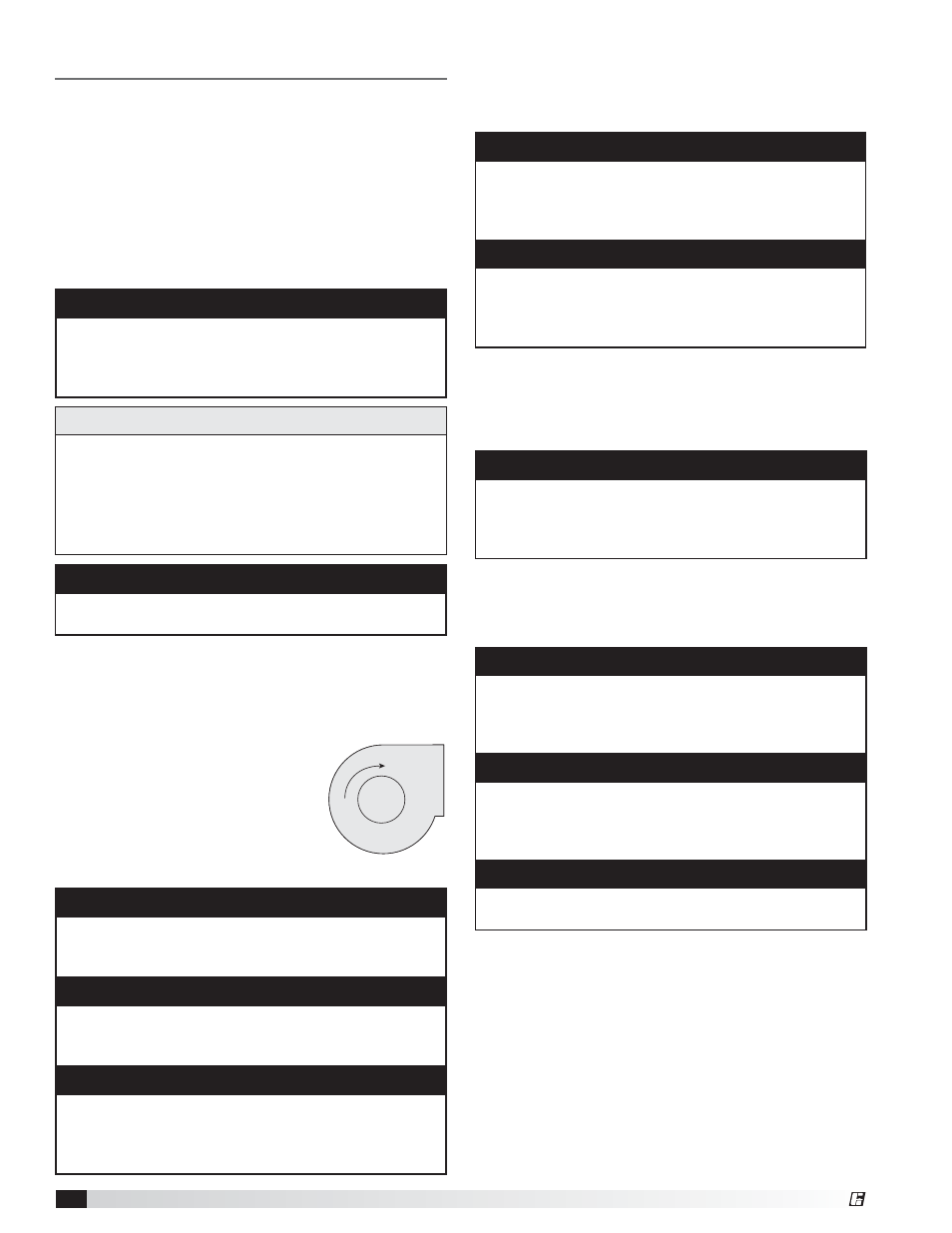Start-up - blower – Greenheck TSU Base Unit Manual (464441) User Manual
Page 12

Make-Up Air Unit
12
®
Start-Up - Blower
Refer to the Start-Up Checklist in the Reference
section before proceeding further!
Pre Start-Up Check
Rotate the fan wheel by hand and make sure no parts
are rubbing. Check the V-belt drive for proper alignment
and tension (a guide for proper belt tension and
alignment is provided in the Belt Maintenance section).
Check fasteners, set screws and locking collars on the
fan, bearings, drive, motor base, and accessories for
tightness.
1. Check the Voltage
Before starting the unit, compare the supplied voltage,
hertz, and phase with the unit and motor’s nameplate
information.
2. Check the Blower Rotation
Open the blower access door and
run the blower momentarily to
determine the rotation.
Arrows are placed on the blower
scroll to indicate the proper
direction or reference the example
shown to the right.
WARNING
Check the housing, blower, and ductwork for any
foreign objects before running the blower.
NOTE
To reverse the rotation on three phase units,
disconnect and lock-out the power, then interchange
any two power leads.
NOTE
To reverse the rotation on single phase units,
disconnect and lock-out the power, then rewire the
motor per the manufacturer’s instructions.
IMPORTANT
If the blower is rotating in the wrong direction, the unit
will move some air, but will not perform as designed.
Be sure to perform a visual inspection to guarantee
the correct blower rotation.
WARNING
Disconnect and lock-out all power and gas before
performing any maintenance or service to the unit.
Failure to due so could result in serious injury or death
and damage to equipment.
6. Set-Up Optional Components
Adjust the settings on the optional components. See
the Control Center Layout in the Reference section for
location of optional components.
• Heating Inlet Air Sensor
Typical setting: 60-70ºF
• Cooling Inlet Air Sensor
Typical setting: 75ºF
• Building Freeze Protection
Typical setting: 5 minutes; 45ºF
• Dirty Filter Gauge
Typical setting: Settings vary greatly for each unit.
3. Check for Vibration
Check for unusual noise, vibration or overheating of the
bearings. Reference the Troubleshooting section for
corrective actions.
IMPORTANT
Excessive vibration may be experienced during
the initial start-up. Left unchecked, it can cause a
multitude of problems including structural and/or
component failure.
IMPORTANT
Generally, fan vibration and noise is transmitted
to other parts of the building by the ductwork. To
minimize this undesirable effect, the use of heavy
canvas duct connectors is recommended.
NOTE
The most accurate way to measure the air volume is
by using a pitot traverse method downstream of the
blower. Other methods can be used but should be
proven and accurate.
IMPORTANT
Changing the air volume can significantly increase
the motor’s amps. If the air volume is changed,
the motor’s amps must be checked to prevent
overloading the motor.
NOTE
To ensure accuracy, the dampers are to be open
when measuring the air volume.
IMPORTANT
Additional starters and overloads may be provided in
the make-up air control center for optional exhaust
blowers. Any additional overloads must be checked
for proper voltage, amps and RPMs.
Blower Rotation
Blower
Housing
R
o
ta
tio
n
SPECIAL TOOLS REQUIRED
• Voltage Meter (with wire probes)
• Amperage Meter
• Pressure Gauges – (refrigerant)
• Tachometer
• Thermometer
• U-tube manometer or equivalent
4. Motor Check
Measure the motor’s voltage, amps and RPM. Compare
to the specifications. Motor amps can be reduced by
lowering the motor RPM or increasing system static
pressure.
5. Air Volume Measurement and Check
Measure the unit’s air volume (cfm) and compare it with
it’s rated air volume. If the measured air volume is off,
adjust the fan’s RPM by changing/adjusting the drive.
Blower Rotation
Blower
Housing
R
o
ta
tio
n
